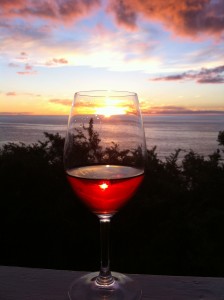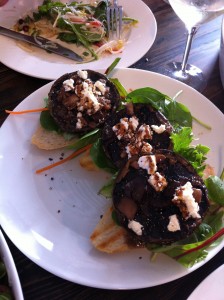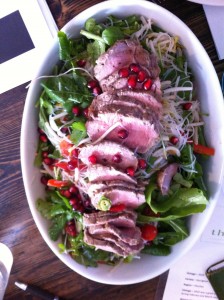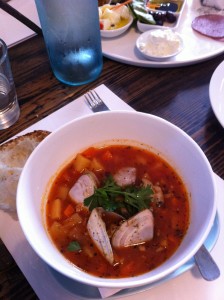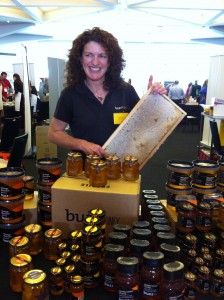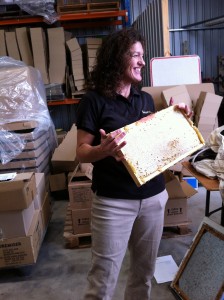Pipi fest
April 28th, 2012My hunch was right, seafood was served at our lunch at Port Elliot, a town on the coast due south from Adelaide (as the crow flies). Lunch at no.58 Cellar Door & Gallery at Waverley Estate www.waverleyestate.com through up a gem: a thinnish tomato coloured broth of diced carrots and potato, mildly spiced with chilli and salted with bacon, brimming with Coorong pipis and seafood. The mushrooms, too, were worthy of mention; big, meaty – described on the menu as fresh field mushrooms – with Matchetts double reduced balsamic & Hindmarsh Valley goats feta. The main was a Thai-inspired salad of muscular Texel lamb strewn with pomegranate seeds. Texel lamb is heavy muscled and lean and gives your jaws a bit of a work out, but that’ll teach us for eating so many soft-as-butter premium cuts!
Dynamic duo making award winning cheeses
April 28th, 2012South of Adelaide you’ll find Ulli Spranz, former Australia Pacific Businesswoman of the Year, and husband Helmut, who produce a range of cheeses, yogurts and butters at BD Farm Paris Creek, made using biodynamic principles. It was Ulli’s dream to make food without chemicals and to make a flourising and viable business. It wasn’t possible to find the land in their native Germany so they spent a year travelling around Australia, looking for a place that had true seasons. Queensland was too warm and humid most of the year but South Australia with its cold winters and hot summers and a rainy season proved to be perfect. Paris Creek was chosen because it has its own water source. The Spranz’s choose to milk cows, not to grow grain, because grain farmers make their income once a year, and with a family, they needed the regular income milking provides. To get a premium for their efforts, they went organic, and farmed bio dynamically, which uses 30% less water than conventional farming. Fertiliers are made from manure. Whey, leftover from cheesemaking, is used as a spray on vegetables and as pig food. Waste water is transferred to a holding pond and recycled into liquid manure.
The aim was to raise a healthy family, and, to that end, to help contribute to the health of the nation.
The soft and creamy and semi-soft cheeses are all award winners and available for sale at the farm.
Thank a bee for what’s on your plate
April 28th, 2012Jude Crowe from Buzz Honey explains how three of every five mouthfuls of food consumed in this world are dependent on the work of a bee to transport pollen from one plant to another. It sounds simple, but understanding the importance of keeping the bee industry healthy and thriving is anything but. The Crowes, that’s Jude and Tim, started beekeeping in 1999, keeping bees in native plantations to ensure the bees have opportunity to visit areas with botanical diversity. The bees are attracted not just by the smell and taste of nectar, but also by how the flower is positioned on a plant. In Jude’s estimation you need around 400 hives to make a living. The Crowes keep 1000. With around 50,000 to 80,000 bees in each hive, that’s a lot of winged neighbours they don’t want to upset!
Recently, on the front page of New Zealand’s most widely read newspaper, the NZ Herald, there was a report saying that honey was one of the foods that should be cut down or cut out of a modern diet (to slow obesity). What utter nonsense. Honey is an ancient food, and our bodies have been accustomed to eating it for thousands of years. It is digested in the large intestine and does not give a sugar rush. The thing to cut down or cut out is processed white sugar.
Then there is the question of heating honey. As heating honey destroys much of its healthful properties, what about the ‘flu, sore-throat cure-all, a hot lemon and honey drink, a mix of freshly squeezed lemon juice and honey (and in NZ we are lucky to have manuka honey made from the native manuka shrub, which possesses antibacterial and antifungal properties), to which boiling water is added to make a soothing drink. Is the goodness from the honey, the very ‘medicine’ this drink is renowned for, destroyed by the heat? Apparently not. Honey can withstand high temperatures for a short period without apparent loss of nutrients.
Jude Crowe
Our very life depends on bees (check out the dvd Queen of the Sun). In 2006 50% of the USA’s commercially managed bee colonies died, a syndrome coined Colony Collapse Disorder. Bees are the legs of plants. They transfer pollen to the female part of the flower. Plants need bees to move their genes and bees are willing collaborators. www.honeybee.org.au/pdf/PollinationAwareFactsSheet.pdf
What can you do to help? The Crowe’s hives need around 300 litres of water a day. If you have a swimming pool or source of fresh water where bees come and drink, consider floating a few corks on top of the water so bees can perch while drinking, instead of risking drowning. Consider having a hive in your back garden, on your roof, at your beach house, on top of your office building. There are companies in New Zealand who look after the bees for you. You just provide a unique spot for the bees with your local. The honey is not yours, but the beekeeper kindly gives you half the honey harvested. The proverbial win-win arrangement (bees, beekeeper, you, the plant).
